Key takeaways:
- Homelessness impacts mental health, education, and job opportunities, highlighting the need for societal awareness and empathy.
- Charity is essential for providing not just basic needs but also dignity and hope, fostering community involvement and awareness.
- Effective campaigning requires personal connections, storytelling, and innovative outreach methods to resonate with audiences and encourage engagement.
- Communication, adaptability, and self-care are critical for the success and sustainability of charity campaigns.
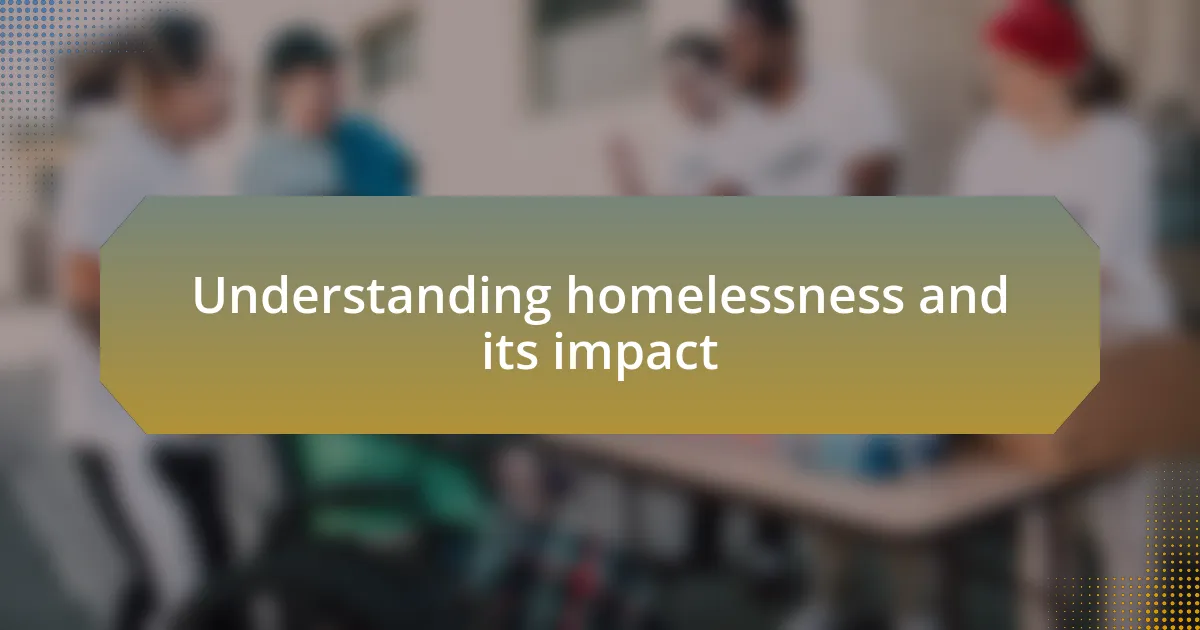
Understanding homelessness and its impact
Homelessness is a complex issue that affects not just individuals but entire communities. I remember volunteering at a local shelter where I met a young boy, no more than ten, who was living in his family car. Seeing his bright eyes, filled with hope despite their dire situation, made me wonder: how can we as a society let this happen?
The impact of homelessness often extends beyond the lack of a physical home; it touches mental health, education, and even job opportunities. During my time advocating for the homeless, I learned that many individuals struggle with feelings of worthlessness and despair. It was heartbreaking to hear stories of those who faced not only the challenge of finding shelter but also the emotional toll it takes—like a heavy cloud that follows them everywhere.
When I think about the ripple effect of homelessness, it’s staggering. Children who become homeless today may find themselves ensnared in a cycle that can last for generations. What can we do to break that cycle? In my experience, awareness and empathy are crucial first steps in humanizing this issue, reminding us that every statistic reflects a unique story waiting to be told.

Importance of charity in homelessness
Charity plays a vital role in combating homelessness by providing essential services and support to those in need. I remember attending a fundraising gala where every dollar raised helped fund shelter programs. Seeing the community come together in solidarity made me realize just how powerful collective efforts can be in changing lives, not just temporarily but in meaningful, lasting ways.
Through my experience volunteering, I’ve seen charities offer more than just a warm meal or a roof over one’s head; they provide dignity and hope. One evening at the shelter, I spoke with a woman who had just landed a job thanks to job training provided by a local charity. Her smile as she recounted her journey reminded me that these organizations are lifelines, helping individuals regain their sense of self-worth.
Moreover, charity fosters awareness about homelessness, creating a ripple effect of empathy and understanding within the community. Every time I share my experiences at local events, I see how questions arise from the audience—like, “What more can I do?” This curiosity is the spark that fuels further involvement and advocacy, making charity not just a solution, but a bridge that connects us all in the fight against homelessness.
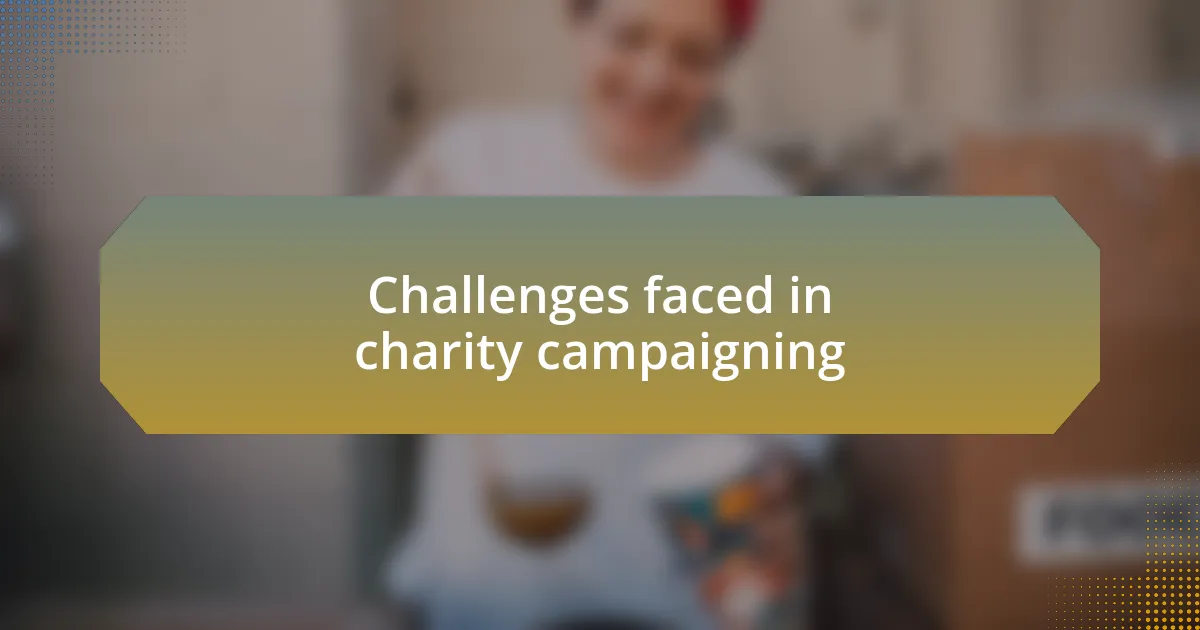
Challenges faced in charity campaigning
Campaigning for charity is not without its hurdles. One major challenge is securing funding. I vividly remember organizing an event where we put in countless hours planning and promoting only to find that sponsorships fell short. It’s disheartening when you invest so much energy, and then the financial backing doesn’t materialize. How do you rally your support team when the numbers aren’t adding up?
Another frequent obstacle is raising public awareness in a saturated market. With so many causes vying for attention, it can feel nearly impossible to make your message stand out. I once hosted a community forum that aimed to shed light on homelessness. While the turnout was decent, I couldn’t shake the feeling that many attendees were simply there for the free food. How can we ensure that our message resonates and encourages sustainable engagement?
Then there’s the emotional toll that comes with confronting the harsh realities of homelessness. Each story shared can weigh heavily on anyone involved. I recall a conversation with a local leader who had experienced incredible loss yet continued to fight for change. It made me realize that while the challenges can feel overwhelming, the hope that emerges from these encounters inspires us to persevere. How do we transform that heaviness into a driving force for action? The answer lies in the strength of community and the passion we share.
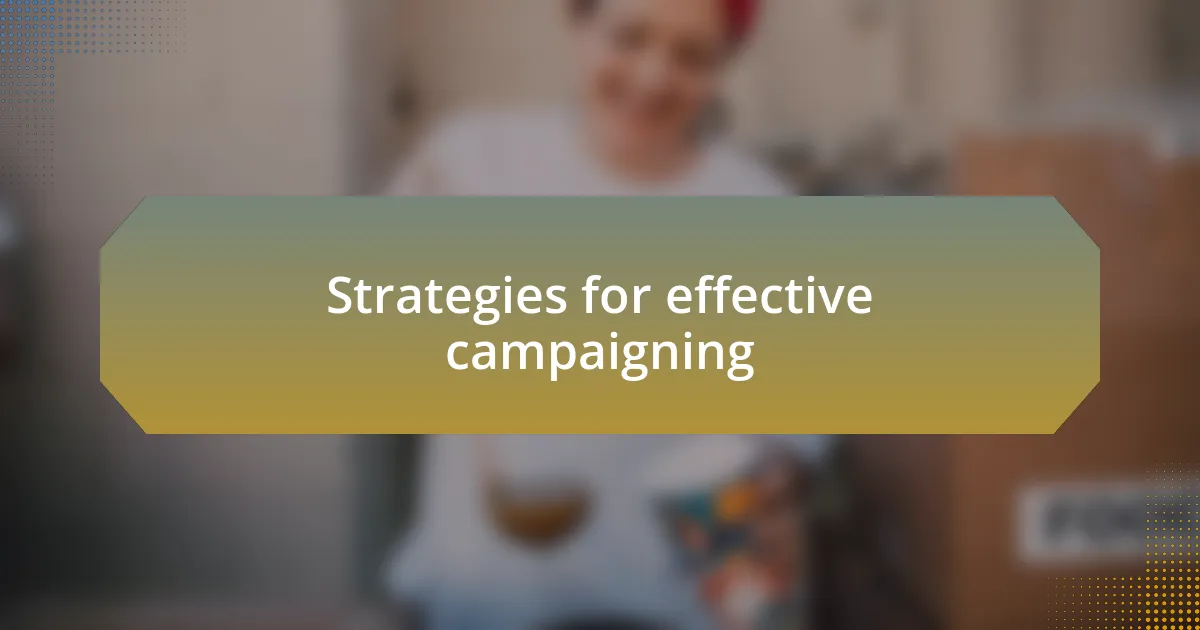
Strategies for effective campaigning
Engaging with the community is at the heart of effective campaigning. I’ve learned firsthand that creating personal connections can amplify your message. For instance, I once spent an afternoon volunteering at a local shelter and found that sharing my own experiences often opened doors to deeper conversations about homelessness and our shared responsibility. How do you build those connections? I believe it starts with authentic listening, allowing others to share their stories and insights, which not only fosters trust but also enriches your campaign narrative.
Storytelling is another powerful strategy I’ve seen work wonders. There was a time when we decided to highlight individual stories of those we aimed to help rather than broad statistics. One poignant story was about a single mother who overcame incredible odds to find stable housing. I could see how her journey resonated with our audience, sparking empathy and action. How can we harness such emotional depth? By framing our campaigns around personal narratives, we not only elevate those voices but also create a more compelling case for support.
Lastly, I’ve realized the importance of experimenting with various outreach methods. During one campaign, we used social media to engage younger audiences by launching a challenge that invited people to share their takes on homelessness. Some of the responses were intriguing, and as a result, one post went viral. It was a reminder that innovation doesn’t just draw attention; it can foster a sense of community involvement. How can we encourage creativity in advocacy? I suggest brainstorming sessions with team members and community participants to come up with fresh ideas, ensuring everyone feels invested and motivated.

Personal experiences in overcoming challenges
I remember a particularly challenging moment during one campaign when our funding fell through just days before a major event. Panic set in, but I quickly rallied the team to brainstorm alternative fundraising strategies. In that moment of uncertainty, we found strength in our collective creativity, leading us to organize a last-minute crowdfunding initiative that not only met our financial needs but also deepened our commitment to supporting one another.
Another challenge I faced was dealing with opposition from those who didn’t understand our cause. I’ll never forget an encounter with a local business owner who was skeptical about our efforts. Instead of arguing, I invited him to explore our community center and meet some of the families we support. After witnessing their resilience and hope firsthand, he became one of our biggest advocates. Have you ever turned a critic into an ally through understanding? It’s moments like these that highlight the transformative power of empathy in advocacy.
There was also a time when I felt overwhelmed by the sheer scale of the problem we were tackling. It’s easy to get lost in statistics – after all, numbers can feel daunting. But then I chose to focus on one person at a time. I started volunteering one-on-one, hearing intimate stories from those experiencing homelessness. This shift grounded me and restored my sense of purpose. Isn’t it fascinating how personal connections can turn daunting challenges into manageable steps? When I concentrated on individual stories, the larger issue felt a little less insurmountable.
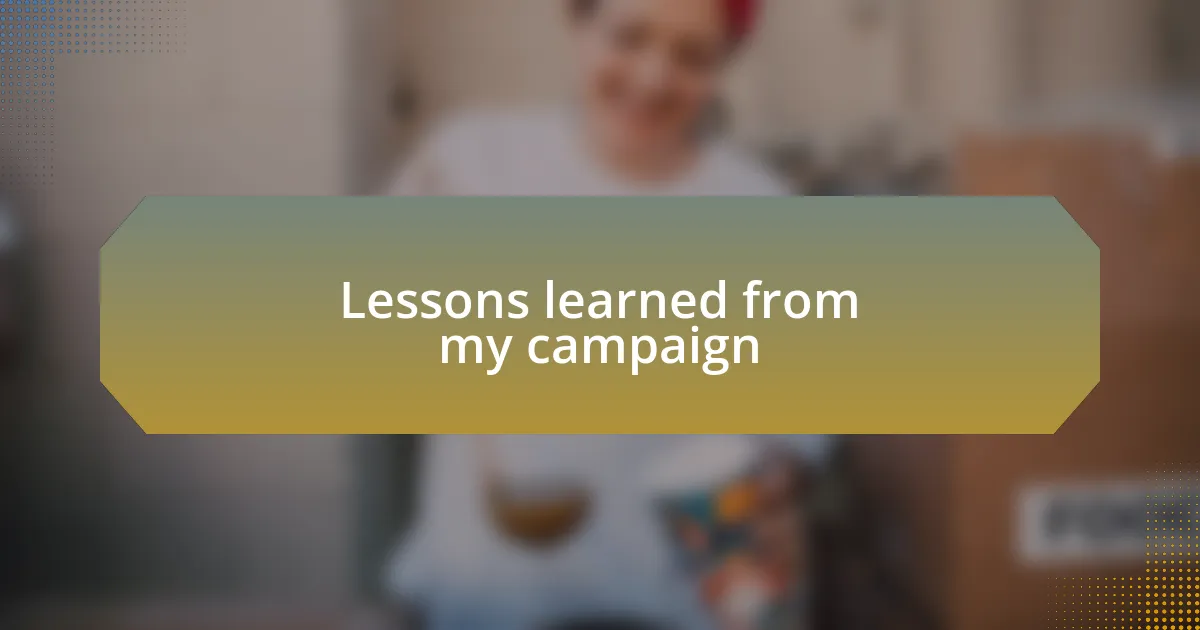
Lessons learned from my campaign
Throughout my campaign, I learned that adaptability is essential. One moment that stands out was when our planned community outreach event was rained out. Instead of viewing it as a setback, I decided to take the conversation online. I created a virtual event, which not only reached more people but also fostered discussions that might not have happened in a crowded room. Have you ever had to pivot unexpectedly? That experience taught me that flexibility can lead to unexpected opportunities.
Another key lesson was the importance of communication. There was an incident when our team misaligned on messaging for a social media campaign. This oversight caused confusion in our supporters and diluted our message. After realizing the impact, I initiated regular check-ins for clarity and cohesion. Isn’t it interesting how transparent communication can energize a team? By ensuring everyone was on the same page, we created a unified front that resonated more with our audience and fostered trust.
Moreover, I discovered that self-care is not just a personal need but an organizational necessity. One time, I was so consumed with the campaign’s demands that I neglected my well-being, leading to burnout. It took a supportive team member gently reminding me to take a break for me to understand that sustainability in our efforts depends on our health too. How can we effectively support others when we neglect ourselves? This realization prompted me to implement wellness breaks for our entire team, ultimately enhancing productivity and morale.
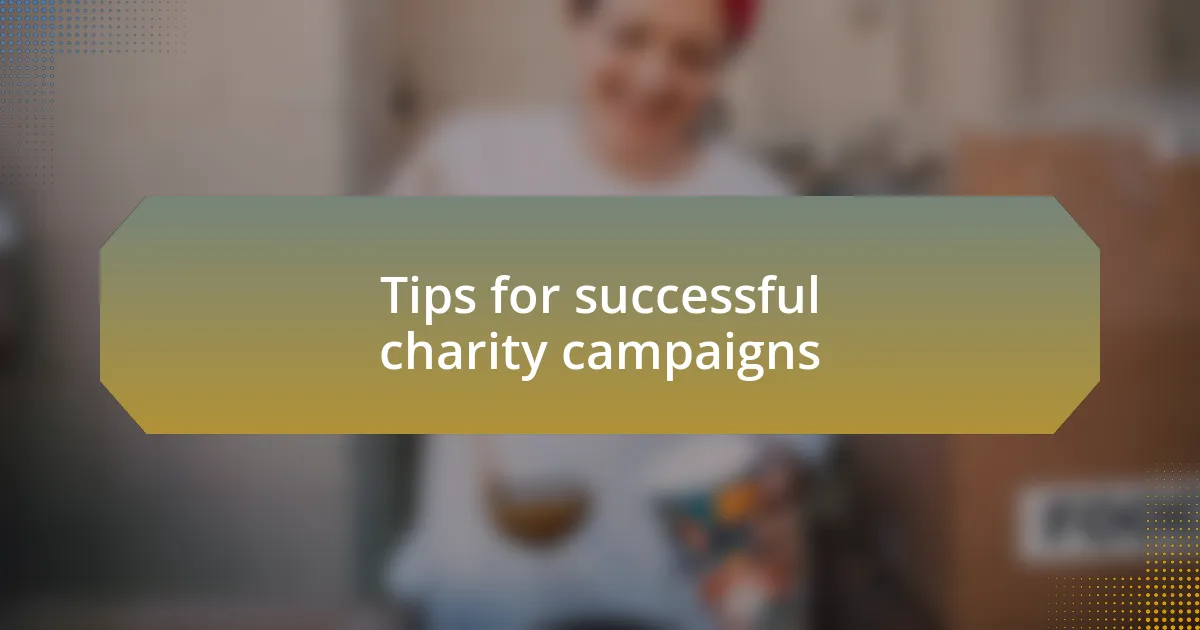
Tips for successful charity campaigns
When it comes to running a successful charity campaign, engaging your audience is paramount. I recall a moment during our fundraising drive when we shifted our strategy to incorporate storytelling. By sharing real-life testimonials from individuals affected by homelessness, we not only connected on an emotional level but also inspired our donors to become advocates. Have you considered the power of personal narratives in your campaigns?
Another vital tip is to leverage partnerships within your community. During one campaign, I reached out to local businesses for support, which led to unexpected collaborations. This not only broadened our reach but created a sense of shared purpose. How often do you think about all the potential allies in your backyard? Collaborating with others can amplify your impact and make your efforts more sustainable.
Lastly, I’ve learned that following up is crucial in maintaining relationships with donors and supporters. After one major event, I personally reached out to thank attendees and share the campaign’s successes. This simple gesture transformed casual supporters into dedicated allies. Isn’t it amazing how a small act of appreciation can foster lasting connections?